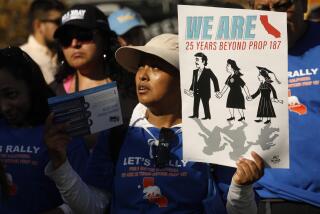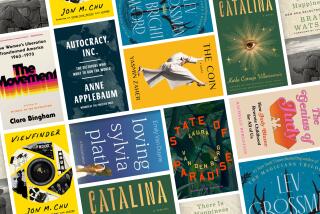A New Perspective on Immigration Views
- Share via
Remember the Statue of Liberty’s offer to take in the world’s poor? With the recession possibly taking yet another dip, more and more people apparently agree with quirky former Colorado Gov. Richard D. Lamm’s take:
“Today, the U.S. has to look at our own huddled masses first.”
The July 13 issue of Business Week, however, finds a silver lining in the cloudburst of new arrivals to America.
Business Week looks at immigration with articles and with a detailed and intriguing Harris Poll. Both perspectives surprise.
The poll, for instance, belies the conventional wisdom that African-Americans resent immigrants more than non-blacks. While 63% of blacks polled said immigrants take jobs away from American workers--compared to 62% of non-blacks--the black population seems more magnanimous in all other areas.
Blacks, much more than non-blacks, think immigrants bring needed skills, help the U.S. economy and are generally good for the country. Blacks are also far less willing to say that immigrants hurt race relations--even though 73% of blacks (compared to 49% of non-blacks) also believe that most businesses favor immigrants over black Americans.
Opinions aside, the fact is America is an immigrant nation again, approaching the 10% foreign-born population figures last seen around 1930. And Los Angeles is leading the way in total numbers as host city, surpassing even New York in immigrants. Without immigrants, Americas cities would have shrunk by 6.8%, Business Week calculates. But now 44% of L.A.’s population, and 70% of Miami’s, is foreign-born.
In some cities, Business Week reports, immigrants are straining health and education services and grabbing jobs--particularly from native-born high school dropouts.
But the magazine also reports that many immigrants, especially those from India, the Philippines, China and Korea, are better educated than the American average, and so provide needed high-tech skills.
Also, immigrants have a flair for tapping the global marketplace.
Finally, deflating another apparent myth, a University of Maryland economist says “immigrants benefit natives through the public coffers by using less than their share of services and paying more than their share of taxes.”
REQUIRED READING
For a good two years before the verdicts in the Rodney King beating case, a steady stream of thoughtful articles on race spilled from magazines. Now it’s a flash flood.
Too much has been reported here already to keep going into detail. But here’s a catalogue of the current crop:
- The July Commentary features about 20 pages of articles from such conservative stalwarts as Charles Murray and Midge Decter.
Decter sample: “Assuming responsibility for one’s life, for one’s everyday choices, as well as for one’s moral conduct, is a practice that has been eroding in American life for a long, long time: every private weakness is by now regarded as a legacy of parental misbehavior, every discomfort as an injustice, every wrong turn as an enforced imposition from outside, every defeat as a malfunction of ‘the system.’ ”
- The August Spin offers “New Jack City” director Mario Van Peebles’ views on the riots: “One thing I thought was kind of refreshing this time around was that a lot of the looting and the rioting was multiracial. There were some white folks; some of my friends who are white were pretty damn upset.”
- The August/September Reason offers the most eclectic collection in a half-dozen libertarian-oriented pieces on the riot. Particularly interesting is Raoul Lowery Contreras’ examination of what happened from the largely neglected Latino viewpoint:
“Across Los Angeles in late April and early May, the impulse to destroy was at war with the impulse to preserve. And on both sides of the struggle were representatives of L.A.’s burgeoning Hispanic population. . . . Of the 3.3 million Hispanics in Los Angeles County, only 2,764 managed to get themselves arrested for riot-related crimes. Of these, 1,500 were suspected of being in the country illegally.”
- The summer issue of Public Interest looks at “The Fate of Black America” with four major articles. Most illuminating is an excerpt from Daniel Patrick Moynihan’s essay, which he wrote in 1965:
“From the wild Irish slums of the nineteenth-century Eastern seaboard, to the riot-torn suburbs of Los Angeles, there is one unmistakable lesson in American history: A community that allows a large number of young men to grow up in broken families, dominated by women, never acquiring any stable relationship to male authority, never acquiring any set of rational expectations about the future--that community asks for and gets chaos. Crime, violence, unrest, disorder . . . that is not only to be expected; it is very near to inevitable. And it is richly deserved.”
- Finally, to quote an article from the August Emerge magazine’s “Special Report From L.A.’s Ashes”:
“Black and white Americans must also believe that their problems can be solved. As Harvard social scientist Orlando Patterson has pointed out, there is not one black problem, there are several interlocking problems--and most affect whites as well as blacks.”
MAGAZINE VS.
MAGAZINE
The appointment of Vanity Fair Editor Tina Brown to replace Robert Gottlieb at the New Yorker may not mark the last gasp of Western Civilization as some New Yorker devotees contend.
But it’s a sufficiently jolting sea change to evoke reportage in all three newsweeklies.
U.S. News & World Report is both philistine and wrong in calling the New Yorker, under Gottlieb, “an increasingly stodgy magazine that has steadily lost readers and advertisers.”
In fact, the magazine’s circulation hit a record high of 632,000 under Gottlieb and remains a healthy 627,263. As for advertising, while Time flatly reports that the New Yorker “lost at least $10 million last year,” Newsweek calls that figure “rumor.” The New Yorker’s president “denies any red ink” to Newsweek, and says that if the huge loss were true, “they wouldn’t be looking for a new editor. They’d be looking for a new president.”
Besides, what magazine--other than Vanity Fair, perhaps--hasn’t suffered advertising losses in these recessionary times?
The “stodgy” charge, echoed to an extent in both Newsweek and Time, is equally bogus. From more adventurous covers to color art to recent articles on Hip Hop and even the use of the F word in recent issues (how often does U.S. News use the F word?), the New Yorker has experienced relatively revolutionary change lately.
It’s unfair and premature to assume that Brown will transform the New Yorker into a forum for vacuous puffery.
But it is also dumb for the newsweeklies to pussyfoot around that possibility. By chiding the New Yorker for “interminable stories on some obscurata or another” (Newsweek) and “its aura of an elegant but musty institution, disdainful of topicality, given to sometimes self-indulgently long and arcane articles” (Time), both pretend the change is about something other than the bottom line.
Loyal readers relish the New Yorker as a last refuge from writing paced to a sitcom attention span and geared to a comic-book sensibility.
They’re not likely to suffer much glitzification to boost owner Si Newhouse’s profit margin.
More to Read
Inside the business of entertainment
The Wide Shot brings you news, analysis and insights on everything from streaming wars to production — and what it all means for the future.
You may occasionally receive promotional content from the Los Angeles Times.










